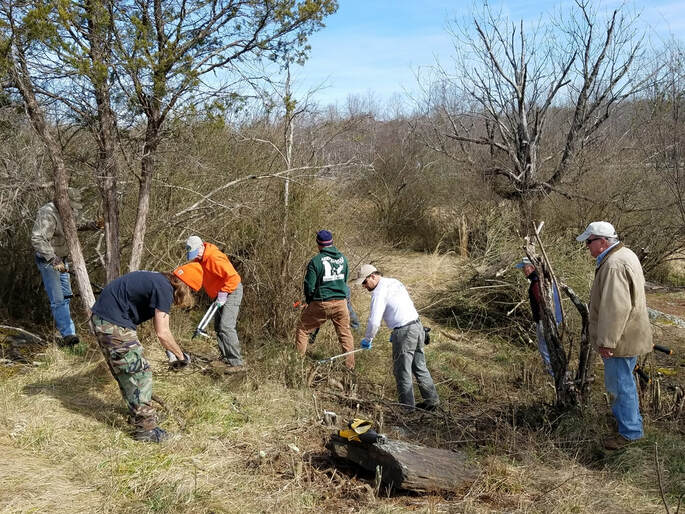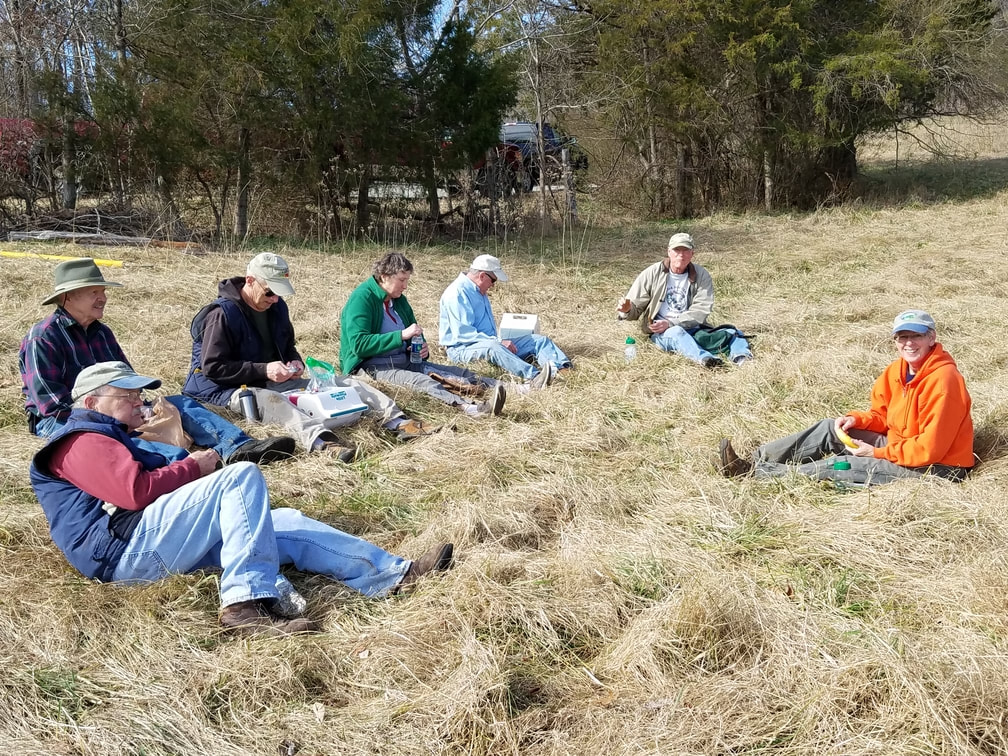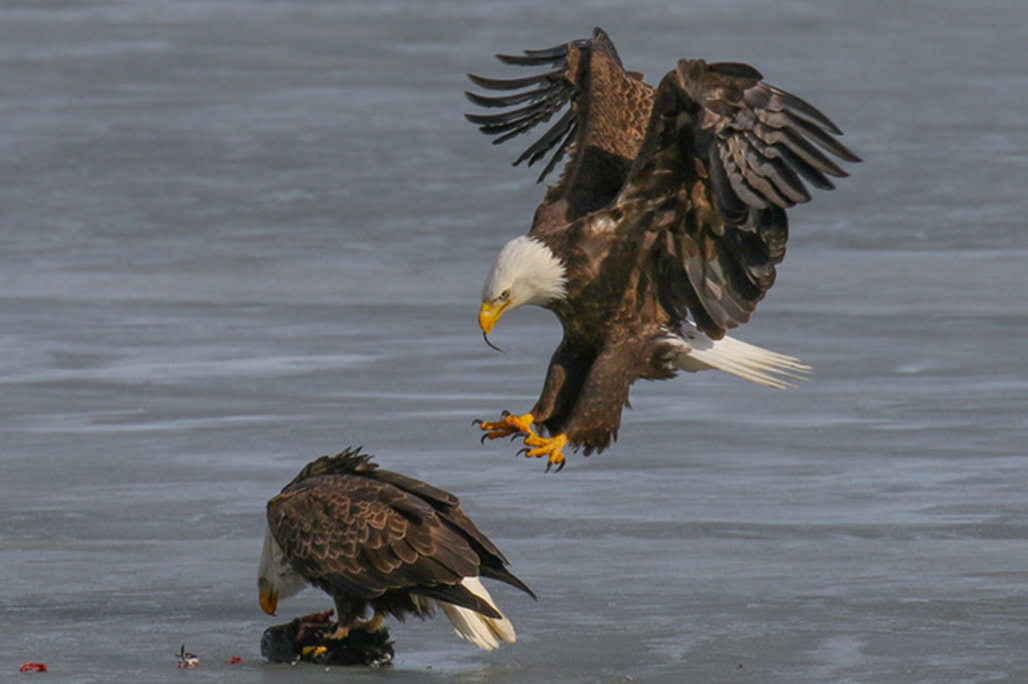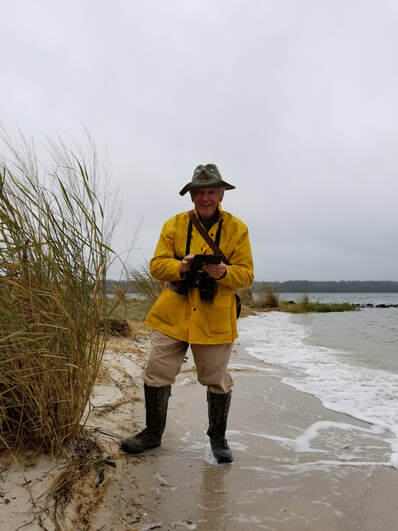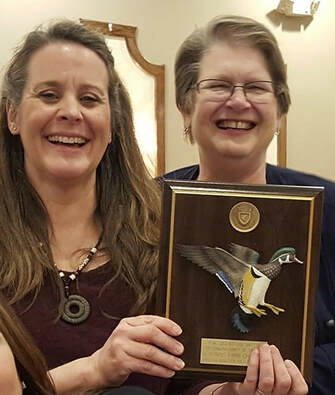 VMN-Merrimac Farm Chapter co-presidents, Lisa Matthews (left) and Rosemarie Nielsen (right).
VMN-Merrimac Farm Chapter co-presidents, Lisa Matthews (left) and Rosemarie Nielsen (right).
Merrimac Farm Chapter Recognized by Ducks Unlimited
Submitted by Lisa Matthews
This year’s Conservationist of the Year chosen by Prince William Ducks Unlimited is the Merrimac Farm Chapter of the Virginia Master Naturalists, located in Prince William County.
In the last year alone, the chapter volunteers have held:
- Stream cleanups to include two “Adopt a Stream” projects in the County and five community stream cleanups. They removed 4560 pounds of trash!
- Water Quality Monitoring including five projects this year monitoring stream quality and teaching in schools, scouts, and universities.
- Meaningful Watershed Educational Experience for K-12 students
- Farm Fields Day- a hands-on experience for students
- City Nature Challenge, a worldwide competition to see who can observe the most nature over a 4-day period. This group identified 767 different species in 2018!
- Bluebell Festival, an annual community event run by the Prince William Conservation Alliance at Merrimac Farm Wildlife Management Area. In 2018, the VMN volunteers taught about the rarity of true blue in nature and guided trail events.
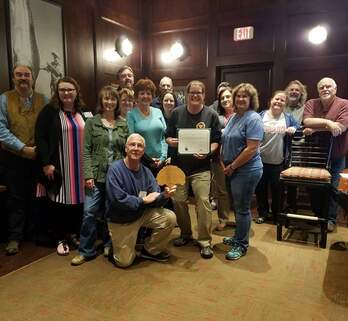 Holston Rivers Chapter volunteers received the great honor of being the Virginia State Parks Volunteer Group of the Year!
Holston Rivers Chapter volunteers received the great honor of being the Virginia State Parks Volunteer Group of the Year!
Holston Rivers Chapter is the Virginia State Parks Volunteer Group of the Year
Submitted by Tanya Hall, Chief Ranger, Visitor Experience, Hungry Mother State Park
Congratulations to the VMN-Holston Rivers Chapter, the Virginia State Parks 2018 Volunteer Group of the Year! The chapter has made outstanding volunteer contributions to Virginia State Parks. Over 50% of the members volunteered almost 300 hours in 2018 at Hungry Mother State Park to provide educational programs on birding, edible plants, wildflowers, aquatic insects, survival, leaf litter and numerous other topics.
They have assisted with field trips, Junior Naturalist programs, VAFP programs, removal of invasive plants and fish, and helped create a natural play area. The Interpretive department would not have been able to host the number nor the quality of programs without this chapter’s time and effort.
An Historic Rivers Chapter Volunteer in the Spotlight
Submitted by Shirley Devan
Adrienne Frank, president of the Historic Rivers Chapter, was selected to be profiled by Next Door Neighbors. The article highlights Adrienne’s service as the president of the chapter, the conservation landscaping work she and her husband Gary Driscole (also a VMN volunteer) have done on their property, and the butterfly-focused education, citizen science, and stewardship projects that she has done.
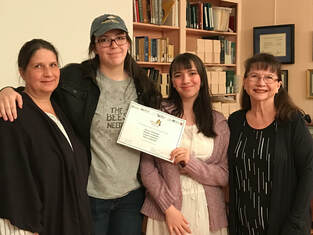 Three generations of women in the Schneider & Whitaker family are VMN volunteers!
Three generations of women in the Schneider & Whitaker family are VMN volunteers!
From the Shenandoah Chapter: Three Generations of VMNs and a new Virginia Wildlife article
Submitted by Karen Fall
The VMN-Shenandoah Chapter was pleased to present Sherry Whitaker, Melanie Schneider, Emma Schneider, and Maya Schneider with the first-ever “3 Generations Award”. Having a family of Virginia Master Naturalists spanning three generations is quite an honor!
Also, if you are a subscriber to Virginia Wildlife magazine, check out the article in the March/April issue titled “Grassroots: A Story of Virginia’s Working Landscapes”, written by Shenandoah Chapter member Marie Majarov. Many VMN volunteers across several different chapters participate in the Virginia Working Landscapes citizen science project with the Smithsonian Conservation Biology Institute.
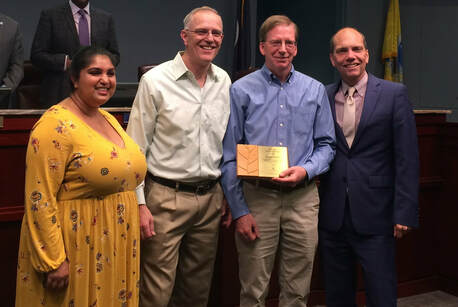 Award presentation with L-R:, Arlington County Parks and Recreation Commission Member Shruti Kuppa and Chair Bill Ross, Bill Browning, and Arlington County Board Member Erik Gutshall. Photo courtesy of Marion Jordan.
Award presentation with L-R:, Arlington County Parks and Recreation Commission Member Shruti Kuppa and Chair Bill Ross, Bill Browning, and Arlington County Board Member Erik Gutshall. Photo courtesy of Marion Jordan.
ARMN Member Bill Browning Receives 2018 Bill Thomas Volunteer Service Award
(Submitted by Kasha Helget, based on article in Arlington County’s Environment webpage.)
On April 25, 2019, Arlington Regional Master Naturalist member, Bill Browning, was honored with the 2018 Bill Thomas Outstanding Park Service Volunteer Award for his volunteer work in Arlington. This award was established to pay tribute to lifelong parks volunteer Bill Thomas and to honor and encourage residents with passionate dedication and support for the county’s dynamic programs, natural resources, and public open spaces.
The transformation of Powhatan Springs Park in Arlington, VA could not have happened without Bill Browning. Bill’s leadership in the restoration work at Powhatan Springs Park had led to the clearing of invasive plant species to reintroduce native flora and fauna to the area; adding significantly to Arlington’s rich biodiversity. Bill led citizen science observation events for the City Nature Challenge at Powhatan that engage members of the general public as well as experts in recording all flora and fauna in in the park and other local areas. The newly created brush piles on the site have welcomed wildlife previously unseen at the park, including a Barred Owl. Bill also helped conduct a tree inventory of the entire park; an ARMN colleague subsequently created a GPS version that shows all the native trees and natural features on the site and will facilitate future volunteer and restoration work there.
In addition to his work at Powhatan Springs Park, Bill has performed additional invasive removal work at several other County parks and Culpepper Gardens Senior Living Community in Arlington, stream water monitoring throughout Arlington, work at the native plant garden at Potomac Overlook Regional Park, and seed cleaning and other nursery work for Earth Sangha, a facility propagates native plants for restoration plantings in the area.
Since joining in 2013, Bill has been an active member of the Arlington Regional Master Naturalists and has contributed over 1,000 hours of volunteer service. Bill has been a true leader and welcoming face within the organization, serving as Membership Chair and creating initiatives such as the mentor program. He also increased communications to help new members connect with current members and easily find volunteer opportunities that best fit their interests.
Always one to further his expertise, Bill recently completed a Certificate of Achievement in Natural History Field Studies through USDA Graduate School and the Audubon Naturalist Society.
Middle Peninsula Chapter Blossoms with New Projects Our newest VMN chapter, Middle Peninsula, received its official chapter charter last month. Chapter leaders have been busy for more than one year planning the chapter, writing the bylaws and operating handbook, developing a website, and organizing new projects to serve the Middle Peninsula area of Virginia.
Some of their accomplishments thus far include:
- A new partnership with the Pamunkey Tribal Resource Center along with an educational exhibit for the Pamunkey Earth Day celebration
- Earth Day cleanup with Zach Bradford, DCR Preserve Manager at Bethel Beach Natural Area Preserve
- Multiple citizen science projects, such as the Community Collaborative Rain, Hail, and Snow Network (CoCoRAHS), FrogWatch USA with the Virginia Living Museum chapter, bird counts, and vernal pool monitoring. They also are in the process of joining the Chesapeake Monitoring Cooperative for water quality monitoring.
- Education projects such as helping with Meaningful Watershed Educational Experiences for Gloucester County Public Schools, an after-school nature club at an elementary school, and schoolyard habitat programs. The Gloucester Daffodil Festival with 20,000 visitors was the chapter’s first big outreach event. The Chapter combined resources with the Gloucester Master Gardeners and Lisa Deaton, Virginia Department of Forestry (VDOF). Our collective presence, nature activities for children, and VDOF handouts about native plants, pollinator gardens, wildlife brush piles, and fire-wise landscapes were all popular with festival visitors. An extra special moment happened during this festival when an Eastern tiger swallowtail fluttered through the exhibit right under the Chapter’s brand new banner with this butterfly in the logo.

